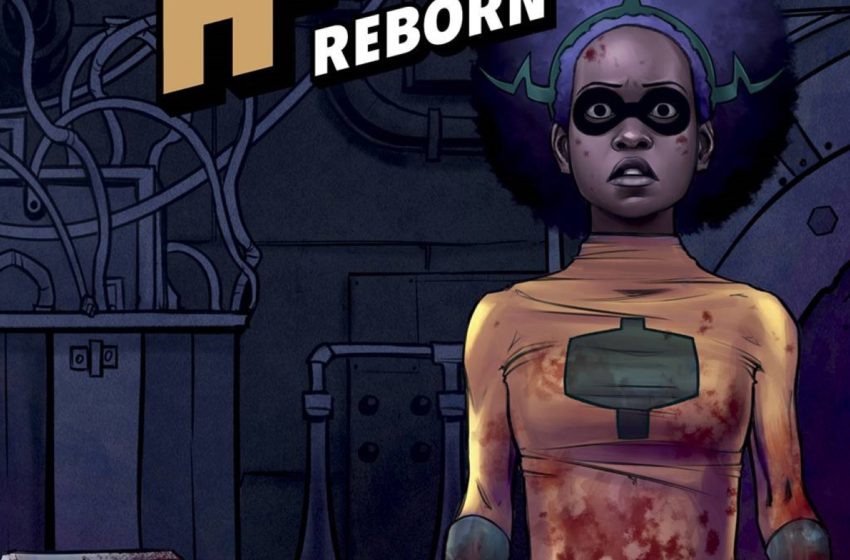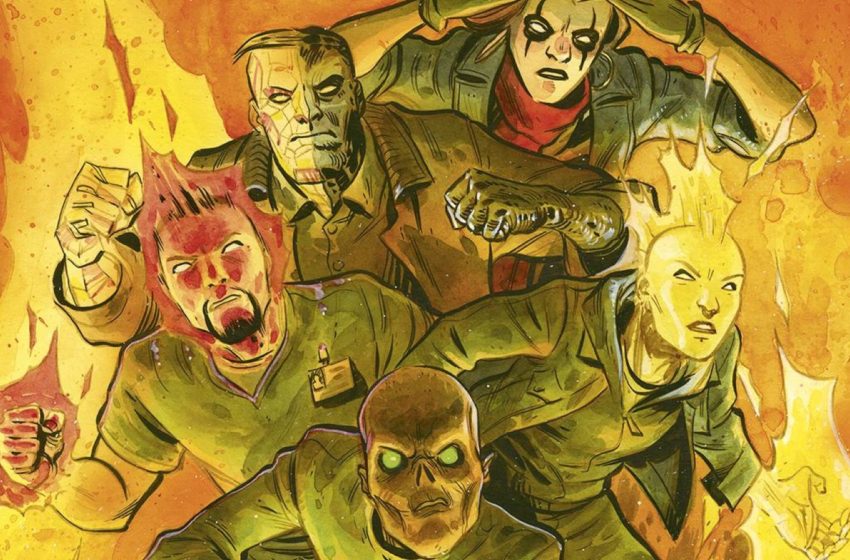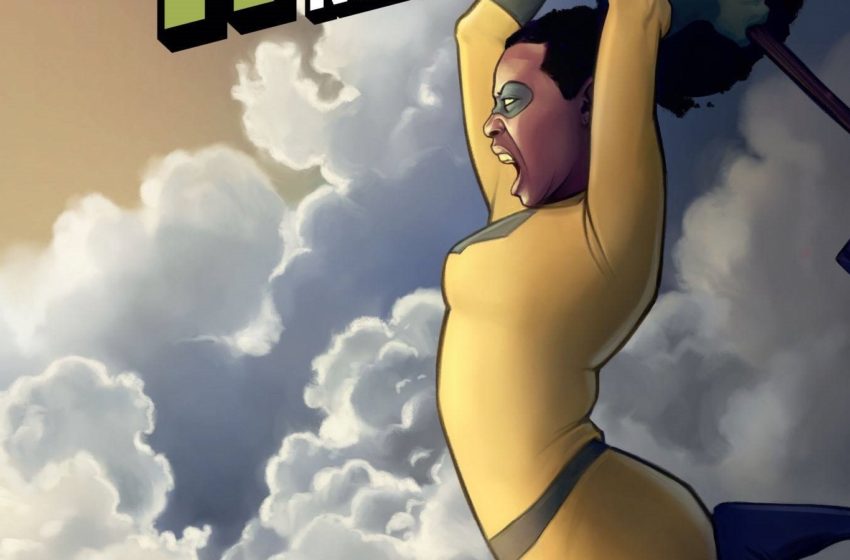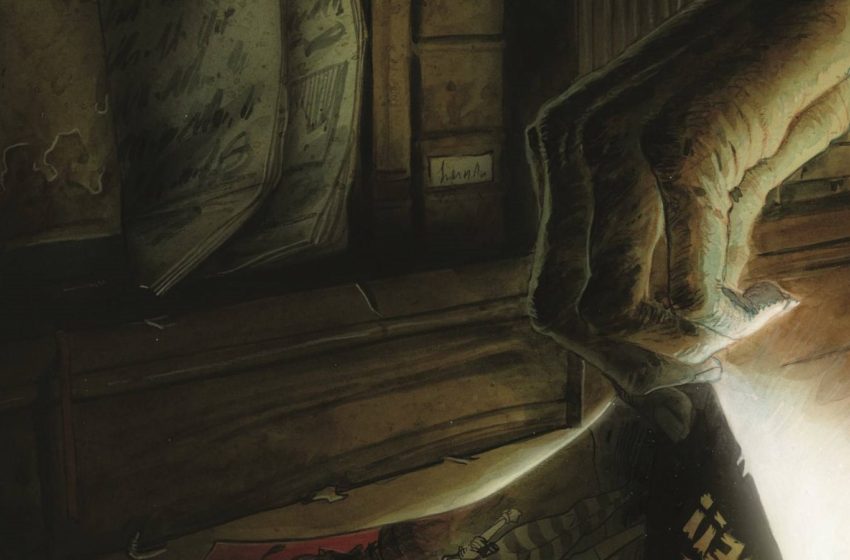Writer Jeff Lemire returns to the World of Black Hammer, this time with artist Caitlin Yarsky, colorist Dave Stewart and letterer Nate Piekos. It’s 20 years later, and Lucy, and the world, have moved on. Living in the suburbs of Spiral City, Lucy is married and has children. But all is not blissful. Her marriage is falling apart, her job has reached a dead end and for mysterious reasons, she hasn’t picked up the hammer in years. But, as her domestic life begins to crumble, the secrets of the last 20 years, and the reasons Lucy really gave up being Black Hammer, begin to resurface, threatening her family, and the peace she has tried hard to find for herself.
Mark Turetsky: Hi, Vishal! I’m glad I’ve got you on board the Black Hammer train to review Black Hammer Reborn with me! So tell me, what’s your history with this particular comic book universe?
Vishal Gullapalli: Glad to be here, Mark! Black Hammer’s a weird marker for me because it’s one of the first, if not the first, non-Big Two comics I’d ever read. I’m very excited to talk about this long-awaited threequel, since CXF wasn’t around for the two prior runs.
Previously on Black Hammer

Vishal: But before we get into this, Mark, I figured it’d be worthwhile to touch a little more on our feelings on the original Black Hammer and Age of Doom. This is a threequel, after all — the first two parts do matter. I was pretty disappointed with the ending to Age of Doom, but I think there was something genuinely fresh and interesting in the first volume of Black Hammer. The mystery of the farm, Lucy’s sudden appearance and ending on her lifting the hammer, all of it was intriguing and compelling. Plus, I genuinely enjoyed Lemire’s blatant pastiches of Big Two characters — a lot of the time these pastiches get tiresome, but I found them charming here — especially Black Hammer himself, a mix between Mister Miracle of the New Gods and Thor of the old. What about you, Mark? How was that old Black Hammer experience for you?
Mark: Before Black Hammer, I mainly knew Lemire through his Marvel work. At that moment, he was writing pretty much half the line. I liked his Hawkeye and Old Man Logan, and his run on Moon Knight was just starting (I tried to read his flagship X-Men title and thought I must be missing something because I’m not an X-Men person [Don’t tell the rest of CXF this, please!] [Grote’s note: I’M TELLING. ZACK! ZACK, YOU SEE THIS?]). So I was interested in seeing what he would do with a superhero world that wasn’t beholden to a Big Two media empire. And Black Hammer really grabbed me.
I thought the emotional honesty (which some might call the dour tone) was really appealing, and I enjoyed the little winks to other comics properties. Also, the art was just fantastic all the way through; Dean Ormston and every guest artist just nailed it. I especially liked Age of Doom, where Lucy begins moving into more Vertigo-style comics spaces (which is more the kinds of comics I had read prior to getting into cape stuff). And that Rich Tommaso-drawn arc featuring Colonel Weird was incredibly fun, and showed a real willingness to dive in and experiment.
And then, with the various spinoffs, some of them I think surpass the mainline ongoing titles (if you’re really interested in what I think of each Black Hammer mini, I wrote a reading guide).
You bring up the ending of Age of Doom, and to say I was underwhelmed would be taking things a bit far. To be perfectly honest, I didn’t even remember the resolution of that series until I reread it in preparation for covering the Black Hammer Universe here. Still, even though the ending was a miss, I thought Age of Doom did some really cool stuff.
Vishal: Yeah, I do think Age of Doom had some fun stuff — I think it got more self-indulgent than I’d like, especially with the very Sandman-esque conclusion to the first arc. There was something that I felt was lost when the initial series ended on Lucy suddenly learning the truth of the farm but forgetting it before she could actually relay it to the team or to the readers. But the Rich Tommaso portion was beautiful, and I could generally accept that Lemire was leaning more on his artists than his own plotting.
The spinoffs were a bit hit or miss for me — I loved Sherlock Frankenstein, Doctor Andromeda (nee Star) was a classic Lemire story, and recently Barbalien and Colonel Weird were fantastic — but ‘45 and Quantum Age didn’t work for me. Justice League/Black Hammer was fun without doing anything of substance, and Skulldigger + Skeleton Boy was gorgeous. I’m definitely more convinced of Black Hammer’s purpose as a universe than a single story — which is why I was a little confused about the announcement of Reborn. But it’s here now.
Mark: Yeah, Vishal, there’s an issue we’re supposed to be talking about here. Are you trying to get us in trouble? [Grote’s note: Hold on Turetsky, you’re still on the hot seat for not having read bad X-Men comics.]
Twenty Years Later

Vishal: OK, so as to not bury the lede: I was not impressed by this issue. Like, at all. Lemire built Black Hammer on intrigue, with the mystery of the farm driving people to read each issue. But here there just isn’t a hook that I can find. Lucy is no longer Black Hammer in the future, and we don’t know why. She has a relatively nondescript home life that gets torn apart before we can even consider it significant. After what I considered a really disappointing resolution to the story of the Farm, this issue did not do much to regain my confidence.
Sorry for opening this on such a down note though, Mark — what’d you make of the issue?
Mark: I think the mystery we’re given in this issue (Why did Lucy stop being Black Hammer?) isn’t as compelling as the multiple hooks we were given in the original Black Hammer series. I agree, this just isn’t as compelling, but maybe that’ll change in future issues (What did Alexander Pope say about hope again?). Is there anything you liked about the issue?
Vishal: It’s a bit of a monkey’s paw thing for me — I mostly liked the art. I had some issues with telling characters apart (or maybe it’s just that Lucy’s husband and boss were nondescript and I smushed them together in my head), but for the most part the art really sold that this was something new and more of a classic superhero story, rather than the ethereal weirdness of Ormston’s depiction of the Farm. Caitlin Yarsky is a solid artist, one who’s generally able to depict everything Lemire’s putting into the story.
Which is where the monkey’s paw curls — she’s not really able to stretch her legs and show what she’s able to do, since the story is so centered on the mundaneness of Lucy’s new life. The best part was obviously whatever the green energy horror monster thing is, since it’s clearly going to be central to whatever the main story is. I hope to see more of it.
Mark: That seems to be a tear in space leading to the Para-Zone. I also love Yarsky’s art in this. The first pair of panels on the page where Lucy is going to see Reyes feature some incredible faces on the background characters. Each one is distinct and just so wonderfully expressive, even though it’s just some people going about their drab, wretched lives.
There’s also a wonderful use of integrated sound effects with a THOOM a few pages later. It’s kinda frustrating, because we get a few glimpses of what Yarsky can do with superhero action in the flashback scene with the regrettably named supervillain Black Hole. The spaghettification effect she draws, Lucy as Black Hammer doing Cool Superhero Shit, it all works so well, and I think it’s their way of saying “don’t worry, cool stuff is coming.”
We know that Lucy (or someone else! maybe her daughter Rose?) will be lifting the hammer at some point, so it’s up to Lemire to make something compelling to fill the space until that happens. I think the reveal of why she gave up the hammer really needs to be a helluva payoff.
Black Hammer … Murderer?!

Vishal: Speaking of that reveal, we do get a little tease at the end of this issue, but quite honestly it just feels like the age-old Batman debate. No, not the very delightful one that’s been happening on Twitter this week, but the dull “Should Batman Kill People?” debate that’s second in annoyance only to “Bruce Wayne should simply buy crime away.” As far as we can see, it appears that the reason Lucy has given up the hammer is that she killed someone the last time the Para-Zone had some sort of incursion. In a world where Chip Zdarsky’s Daredevil is still ongoing, I can’t help but feel that this is fairly trite. How about you, Mark, do you have any thoughts about what we know so far?
Mark: At first I thought the mystery person might have been Doctor Andromeda, but he’s got wavier hair and would be much, much older at this point in time. Still though, the lab, the incursion, not to mention that we see file footage of Doctor Andromeda in this issue warning about the dangers of the para-zone, it’s likely someone following in his footsteps.
I think it’s possible the whole “she killed someone so now she will never do it again” implication might be a misdirect. In my mind, it could be a more existential threat to the world, like the one posed by Anti-God in the original two Black Hammer series. Maybe her continuing to use the hammer, to be Black Hammer, was what caused the Para-Zone incursion that we see in the flashback. And that’s why she’s so willing to let the (presumably) non-powered government goons from T.R.I.D.E.N.T. take care of things. That’s just me spitballing, though. The spitballs of optimism.
Vishal: You’re absolutely right, of course — this could be a very deliberate framing so that we think it’s going in the really trite way but subverts it. But going in expecting a subversion feels to me like setting myself up for disappointment. There’s definitely room for it, though, especially with the inclusion of the Para-Zone. If there’s one thing that’s always the case with the Para-Zone, it’s that it always serves to complicate things. Usually in a good way.
To look forward a little bit, the next issue’s cover has Skulldigger fighting a big monster. With the inclusion of Reyes in this issue, I’m curious how this series will expand on this “Twenty Years Later” world of Black Hammer. Is Skeleton Boy the new Skulldigger? Is Lucy going to get any spotlight in the next few issues? I can’t wait to find out.
Mark: Skeleton Boy growing up to be the new Skulldigger would be a serious betrayal of the ending of their miniseries, in my opinion. Besides, Skulldigger has that chaos demon blood he inherited from Grimjim, so it’s entirely possible he doesn’t age, either.
Until next month, let’s see what the Para-Zone has in store for us!
Dispatches From The Para-Zone
- The inclusion of Reyes and Skulldigger (and their absence from the two previous Black Hammer ongoings) implies that the Skulldigger and Skeleton Boy mini is really the first Reborn spin-off. Or is Reborn a spin-off of it, chronologically speaking?
- T.R.I.D.E.N.T. gets around in a hot air balloon. You know who else does? Grimjim. I wonder how long it’ll be before he takes over one of T.R.I.D.E.N.T.’s balloons.
- Doctor Andromeda’s warnings on the TV are clearly setup for something — odds that he makes a more substantive appearance as the plot thickens are pretty high.
- We’ve also got another hero who’s big into that Para-scene: Colonel Weird.







